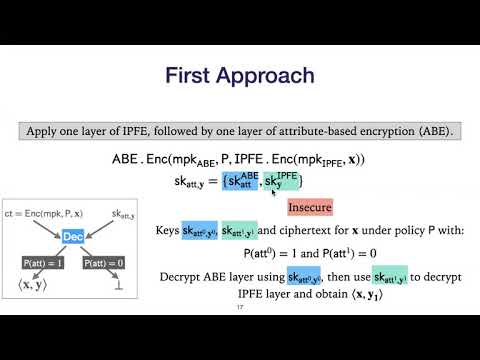CryptoDB
Inner-Product Functional Encryption with Fine-Grained Access Control
| Authors: | |
|---|---|
| Download: | |
| Abstract: | We construct new functional encryption schemes that combine the access control functionality of attribute-based encryption with the possibility of performing linear operations on the encrypted data. While such a primitive could be easily realized from fully fledged functional encryption schemes, what makes our result interesting is the fact that our schemes simultaneously achieve all the following properties. They are public-key, efficient and can be proved secure under standard and well established assumptions (such as LWE or pairings). Furthermore, security is guaranteed in the setting where adversaries are allowed to get functional keys that decrypt the challenge ciphertext. Our first results are two functional encryption schemes for the family of functions that allow users to embed policies (expressed by monotone span programs) in the encrypted data, so that one can generate functional keys to compute weighted sums on the latter. Both schemes are pairing-based and quite generic: they combine the ALS functional encryption scheme for inner products from Crypto 2016 with any attribute-based encryption schemes relying on the dual-system encryption methodology. As an additional bonus, they yield simple and elegant multi-input extensions essentially for free, thereby broadening the set of applications for such schemes. Multi-input is a particularly desirable feature in our setting, since it gives a finer access control over the encrypted data, by allowing users to associate different access policies to different parts of the encrypted data. Our second result builds identity-based functional encryption for inner products from lattices. This is achieved by carefully combining existing IBE schemes from lattices with adapted, LWE-based, variants of ALS. We point out to intrinsic technical bottlenecks to obtain richer forms of access control from lattices. From a conceptual point of view, all our results can be seen as further evidence that more expressive forms of functional encryption can be realized under standard assumptions and with little computational overhead. |
Video from ASIACRYPT 2020
BibTeX
@article{asiacrypt-2020-30702,
title={Inner-Product Functional Encryption with Fine-Grained Access Control},
booktitle={Advances in Cryptology - ASIACRYPT 2020},
publisher={Springer},
doi={10.1007/978-3-030-64840-4_16},
author={Michel Abdalla and Dario Catalano and Romain Gay and Bogdan Ursu},
year=2020
}

